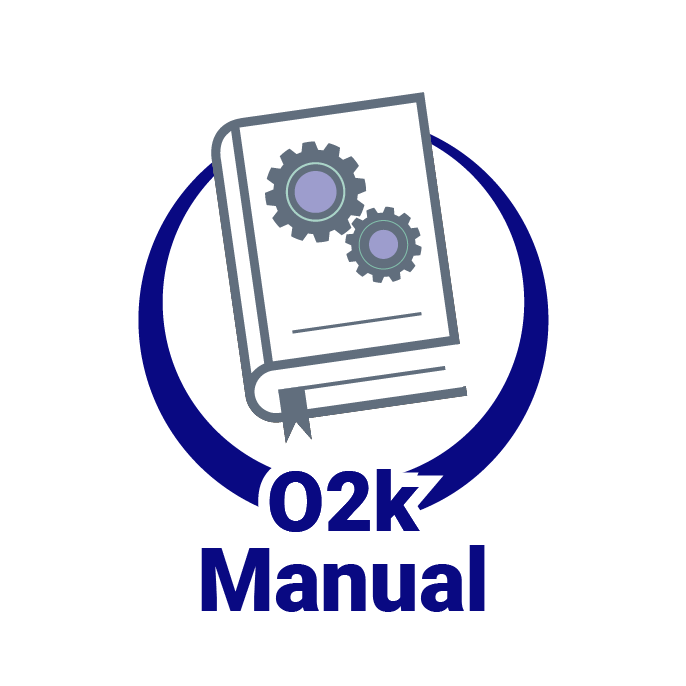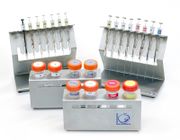Difference between revisions of "O2k-Titration Set"
From Bioblast
| (64 intermediate revisions by 12 users not shown) | |||
| Line 1: | Line 1: | ||
{{ | {{Technical support}} | ||
|description=The '''Titration Set''' consists of | __TOC__ | ||
{{MitoPedia without banner | |||
|abbr= | |||
|description=[[Image:O2k-Titration Set.JPG|right|180px]] The '''O2k-Titration Set''' consists of Hamilton microsyringes (6 x 10 mm<sup>3</sup> and 3 spare plungers, 6 x 25 mm<sup>3</sup>, 1 x 50 mm<sup>3</sup>, 1 x 100 mm<sup>3</sup>, 1 x 500 mm<sup>3</sup>; fixed needles with rounded tips), provided in the [[Syringe Storage Box]] with [[Syringe Labels]], a set of two [[Syringe Racks]] with [[Syringe Collars]], and a set of two [[Tube Racks]]. | |||
| | |||
|info= [https://www.oroboros.at/index.php/product/o2k-titration-set/ '''Product details and purchasing information'''] | |||
}} | }} | ||
: | == Additional resources == | ||
: | :::: »[[MiPNet09.12 O2k-Titrations]] </br> | ||
: | :::: »[[MiPNet19.14 SOP Hamilton microsyringes]] | ||
== | == Note: Titration of chemicals in respirometry == | ||
:::: Overshoots or short interruptions of the flux after the injection of chemicals do not have a meaning in respirometric measurements. A disturbance of the signal is only observed due to the injected chemical and does not represent mitochondrial respiration. With the addition of a chemical solved in ethanol a little bit of oxygen is always introduced, since ethanol has higher oxygen solubility than water. | |||
:::: After a titration, it is common to observe liquid accumulated on top of the stopper receptacle. When this happens, we recommend removing this excess of liquid as it can lead to O<sub>2</sub> backdiffusion into the chamber. For this, we recommend using the [[ISS]], placing the tip close to the capillary, but not directly on top of it. | |||
=== | === Further information === | ||
* | :::* Safety information: fixed needles are used with rounded tips, not usable for injection into tissues. | ||
* | :::* Hamilton microsyringes are specifically produced for O2k-titrations and can be ordered directly from Oroboros Instruments to assure exact fitting with the O2k-Stopper and O2k-Chamber dimensions. | ||
: | :::* Visit also: [http://www.hamiltoncompany.com/products/syringes-and-needles Hamilton]. | ||
: | :::* Eliminate rough edges with 3M™ Wetordry™ Paper Sheet P1000 by gentle rubbing. | ||
: | :::* Use a cleaning wire for the needle. If a syringe is clogged , sometimes it is also helpful to fill it from the back with EtOH or H<sub>2</sub>O and try to press the plunger gently down. | ||
:* | |||
: | |||
:* | |||
{{MitoPedia O2k and high-resolution respirometry | |||
|mitopedia O2k and high-resolution respirometry=O2k-Open Support, O2k-Respirometry, O2k-FluoRespirometry | |||
}} | |||
Latest revision as of 17:46, 11 October 2022
 |
O2k-Titration Set |
MitoPedia O2k and high-resolution respirometry:
O2k-Open Support
Description
The O2k-Titration Set consists of Hamilton microsyringes (6 x 10 mm3 and 3 spare plungers, 6 x 25 mm3, 1 x 50 mm3, 1 x 100 mm3, 1 x 500 mm3; fixed needles with rounded tips), provided in the Syringe Storage Box with Syringe Labels, a set of two Syringe Racks with Syringe Collars, and a set of two Tube Racks.
Reference: Product details and purchasing information
Additional resources
Note: Titration of chemicals in respirometry
- Overshoots or short interruptions of the flux after the injection of chemicals do not have a meaning in respirometric measurements. A disturbance of the signal is only observed due to the injected chemical and does not represent mitochondrial respiration. With the addition of a chemical solved in ethanol a little bit of oxygen is always introduced, since ethanol has higher oxygen solubility than water.
- After a titration, it is common to observe liquid accumulated on top of the stopper receptacle. When this happens, we recommend removing this excess of liquid as it can lead to O2 backdiffusion into the chamber. For this, we recommend using the ISS, placing the tip close to the capillary, but not directly on top of it.
Further information
- Safety information: fixed needles are used with rounded tips, not usable for injection into tissues.
- Hamilton microsyringes are specifically produced for O2k-titrations and can be ordered directly from Oroboros Instruments to assure exact fitting with the O2k-Stopper and O2k-Chamber dimensions.
- Visit also: Hamilton.
- Eliminate rough edges with 3M™ Wetordry™ Paper Sheet P1000 by gentle rubbing.
- Use a cleaning wire for the needle. If a syringe is clogged , sometimes it is also helpful to fill it from the back with EtOH or H2O and try to press the plunger gently down.
MitoPedia O2k and high-resolution respirometry: O2k-Open Support, O2k-Respirometry, O2k-FluoRespirometry





